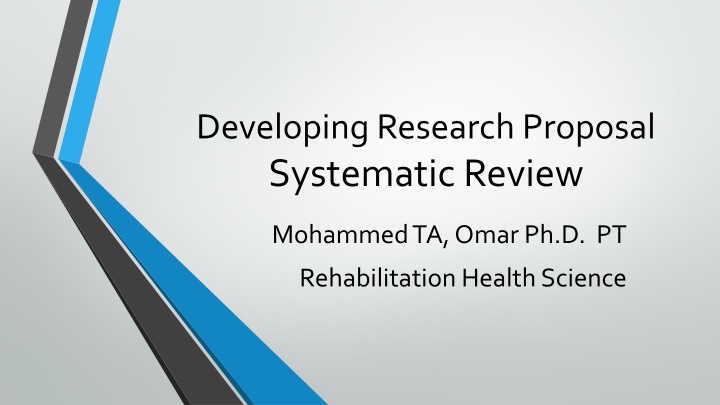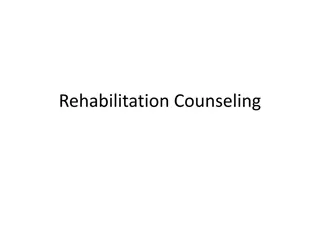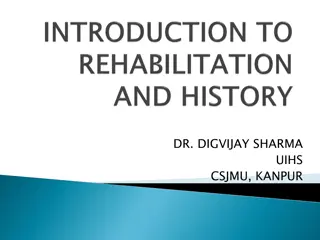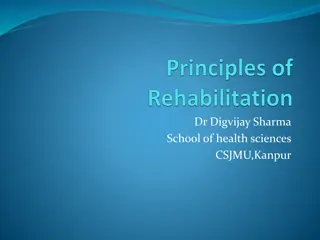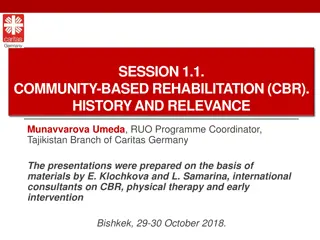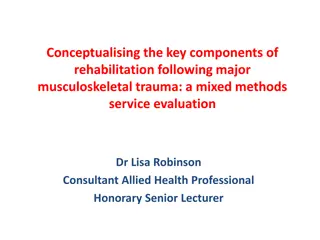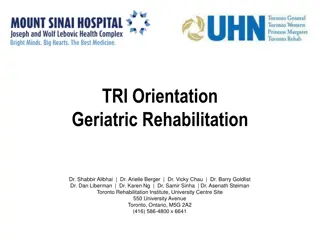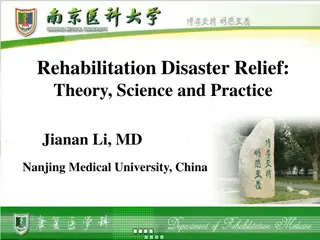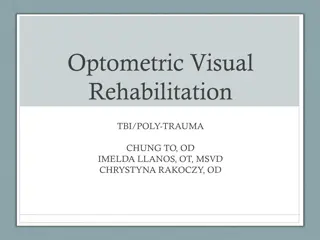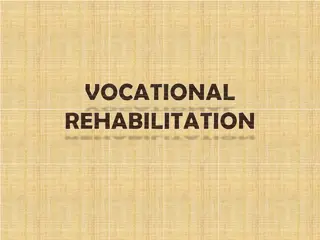Systematic Review in Rehabilitation Health Science
A systematic review is a comprehensive evaluation of existing research on a specific question using structured methods to select, appraise, and synthesize relevant studies. This process aids evidence-based practice, research, and policy formation in healthcare. Systematic reviews differ from narrative reviews in their rigorous methodology and objective analysis. Various types of systematic reviews, such as intervention and prognostic reviews, play a crucial role in informing healthcare interventions and assessing health-status instruments. Key stages in conducting a systematic review include developing a research question using the PICO framework, searching databases, selecting studies, data extraction, quality appraisal, and formulating conclusions. By addressing the challenges of information overload and conflicting results, systematic reviews contribute to advancing knowledge and improving patient care in rehabilitation and health sciences.
Download Presentation

Please find below an Image/Link to download the presentation.
The content on the website is provided AS IS for your information and personal use only. It may not be sold, licensed, or shared on other websites without obtaining consent from the author.If you encounter any issues during the download, it is possible that the publisher has removed the file from their server.
You are allowed to download the files provided on this website for personal or commercial use, subject to the condition that they are used lawfully. All files are the property of their respective owners.
The content on the website is provided AS IS for your information and personal use only. It may not be sold, licensed, or shared on other websites without obtaining consent from the author.
E N D
Presentation Transcript
Developing Research Proposal Systematic Review Mohammed TA, Omar Ph.D. PT Rehabilitation Health Science
What is a systematic Review ? A systematic review is defined as a review of the evidence on a clearly formulated question that uses systematic and explicit methods to identify, select and critically appraise relevant primary research, and to extract and synthesis, analyze data from the studies that areincludedinthereview.
Why ? The problems are that Too much information, too little time Many too poorly done or insufficiently relevant to be clinically useful Many have conflicting results On top of these, high quality information is often not easy to find 3
Why do systematic reviews? Support Evidence Based Practice Research Inform clinical policy Publication Personal professional development
Systematic reviews are the same as narrative reviews Narrative vs systematic review
Types of Systematic Review To assessthe evidence about the effects of a healthcare intervention. Intervention To assessthe evidence about the effects of a healthcare intervention Prognostics To assess the properties of health-status instruments or tools Measurement
Stages of Systematic Review Search bibliographic databases Design search strategy/plan Formulate research question Identify possible papers from titles/abstracts Further selection of primary studies using inclusion criteria Retrieve papers Synthesis Extract data Quality appraisal Formulate research / policy conclusions
Formulate Research Question PICO The first and most important decision in preparing a review is to determine its focus What types of Participants? What types of Interventions? What types of Comparison? What types of Outcomes? This is best done by asking clearly framed questions.
Formulation of a intervention question Does low level laser therapy effective in treatment of diabetic foot ulcer? In patients with Chronic Diabetic Foot Ulcer (DFU), does low level laser therapy lead to higher rates of healing as compared to standardized wound care?
Design Research Strategy/Plan Your development plan should include: 1. Your clinical question 2. Criteria for the literature search Key words Databases Dates to include (how far back do you go?) 3. Inclusion and exclusion criteria Types of studies design Types of participants Types of intervention Type of outcome measurements 4. A timeline for your project
Key Words Key Text words for the condition, e.g., Foot ulcer' , 'diabetic foot ulcer' , 'diabetic wound', 'diabetic complications' Key Text words for the intervention, e.g., Low level Laser Therapy Low Power Laser Low Energy Laser Laser Bio-stimulation Dates to include (how far back do you go?) Time of the fist review (if possible) No systematic review before ( back for 10 years)
Data sources for a systematic review Electronic databases MEDLINE and EMBASE Specialized or local databases (CINAHL, CENTRAL, AMED, ) Hand searching Grey literature ( thesis, Internal reports, pharmaceutical industry files) Checking reference lists Unpublished sources known to experts in the specialty (seek by personal communication) Raw data from published trials 12
Criteria Intervention Participants Study designs Outcomes RCT Case control Cohort study sex Age Conditions Parameters Comparison to other intervention Placebo Sham Primary Secondary
Exercises: As group carful read the following paper and selected the following Research questions Keywords Date of search Language of search Types of data base Criteria of search
Study Timeline Project Tasks Timeline 1. Project Development Plan 2. Perform Literature Search 3. Inclusion/exclusion of Articles 4. Table of Evidence/Data Extraction 5. Table of Evidence Review 6. First Draft of Review 7. Committee Review 8. External Review
Synthesis and Critical Appraisal Data Extraction (draw diagram ) Create Tables of Evidence Methodological Quality
Create Tables of Evidence Most common approaches to classification and grading of the evidence Sackett 's 5 levels of evidence Oxford Centre for Evidence-Based Medicine levels of evidence
Methodological Quality: Jadad Scale Score JADAD SCAL Criteria +1 1a. Was the study described as randomized? +1 1b. Was the method of randomization described and appropriate to conceal allocation? -1 1c. If described and inappropriate, describe: +1 2a. Was the study described as double blinded? =1 2b. Was the method of double-blinding described and appropriate to maintain a double-blinding? -1 2c. Was the method of blinding inappropriate? +1 3. Was there a description of withdrawals and drop outs? Total (0-5) 5
Systematic Review to User Product Using the synthesis of evidence resulting from you review What would you take as a next step for each of the following audiences CLINICIANS RESEARCHERS CONSUMERS
